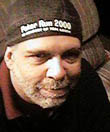|
|
This topic comprises 3 pages: 1 2 3
|
|
Author
|
Topic: Different types of splicing tape
|
Bruce McGee
Phenomenal Film Handler

Posts: 1776
From: Asheville, NC USA... Nowhere in Particular.
Registered: Aug 1999
|
 posted 09-02-1999 03:26 PM
posted 09-02-1999 03:26 PM




I recently bought 10 rolls of "Quik splice" mylar tape made by Hudson Photographc Ind. The guy I bought it from threw in 4 extra rolls of tape: 2 have a yellow line printed across the tape. Ment to show where to line up the perfholes, I guess, and 2 have red lines. Is this just an easy way to see if it is your splices that are buckling, etc. or is it just for general identification.Also, the "quik splice" tape is in plastic wrap. I am leaving it in the shrink until I need it. Any suggestions on storage? I decided to use up the yellow tape first. You dont see the yellow line onscreen unless you are repairing damaged sprocket holes (not my prints-haha) I will appreciate all answers. Brad: we need Film Guard here in the mountains of NC! Bruce
| IP: Logged
|
|
|
|
|
|
|
|
|
|
|
|
|
|
|
|
|
|
|
|
|
|
|
|
|
|
|
|
|
|
|
|
All times are Central (GMT -6:00)
|
This topic comprises 3 pages: 1 2 3
|
Powered by Infopop Corporation
UBB.classicTM
6.3.1.2
The Film-Tech Forums are designed for various members related to the cinema industry to express their opinions, viewpoints and testimonials on various products, services and events based upon speculation, personal knowledge and factual information through use, therefore all views represented here allow no liability upon the publishers of this web site and the owners of said views assume no liability for any ill will resulting from these postings. The posts made here are for educational as well as entertainment purposes and as such anyone viewing this portion of the website must accept these views as statements of the author of that opinion
and agrees to release the authors from any and all liability.
|

 Home
Home
 Products
Products
 Store
Store
 Forum
Forum
 Warehouse
Warehouse
 Contact Us
Contact Us




 Printer-friendly view of this topic
Printer-friendly view of this topic

















